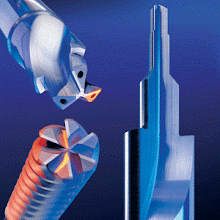Generally workpiece materials are divided into 2 main groups. metallic and non-metallic. Most of the materials are metallic, however there has been an increase in the machining of non-metallic materials such as wood,resins,graphite and glass reinforced plastics (GRP).
Figure 2. I shows a simplified diagram of the main kinds of metals. These materials can be separated into two groups "ferrous” and "non-ferrous” materials. These materials are-used in a wide range of applications. "Steel" is a "material that consists mainly of iron but is alloyed with a small amount of carbon." As the amount of carbon increases the steel then changes and becomes a "Cast iron".
1.1 Iron
Iron, a material that has been used for since 2000BC, has been and still is a widely used material. Therefore there are occasions when people tend to make simple mistakes. For example, even when products that are made of aluminium and copper some people will still refer to it as iron, as they automatically associate anything made of metal as being iron.
Iron, that has been around for so long and so often relied upon. is seldom used in its raw state of pure iron. Generally. when talking about "iron" it tends to mean iron that has been alloyed with a small amount of carbon thus providing a "steel" and/or "cast iron."
1.2 Steel
1.2-1 Steel
Once iron ore has been extracted from pig iron, an additional process is carried out on the iron ore. This additional process is carried out so as to remove certain impurities and gases from the iron ore. Impurities removed range from excessive carbon (C), silicon (Si), phosphorus (P), sulfur (S), and gases like oxygen (0), nitrogen (N). Once this process has been completed the final product is "steel". Note however that in the steels group there are variations based on the chemical composition. The main groups being. carbon steel, alloy steel, tool steel and special-purpose steel.
1.2-2 Carbon steel, Alloy steel
Carbon steel is a steel that consists mainly of two elements iron (Fe) and carbon (C). Whereas alloy steel is a steel that has had a variety of elements alloyed into it to purposely change the chemical characteristic to enhance certain properties.
1.2-3 Tool steel
Within the tool steel group there are three sub-groups. These are known as carbon tool steel, alloy tool steel and high-speed tool steel. One of the main requirements of tool steels is to have both hardness and toughness. To achieve the correct hardness and toughness it is necessary to heat-treat the materials. In order to make the heat-treating process more effective tool steels tend to have a slightly higher carbon (C) content.
Carbon tool steel : contains more carbon (more than 0.6%) than carbon steel. careen tool steel has poor heat resistance and at temperatures that exceed 200 °C the effects of hardening reduce and the overall hardness can not be maintained .
Alloy tool steel : Is a steel that is manufactured by alloying a variety of other elements to carbon toot steels. The reason for alloying other materials is to increase its material characteristics. The result of which compensates for the disadvantage of carbon tool steel in regards to the Alloy tool poor, heat resistance properties, shock resistance, and prevents deformation under high heat treatment processes.
Alloy tool steel as a cutting tool oilers better hardness and higher wear resistance at higher cutting edge temperatures. The alements that are generally alloyed are chromium (Cr), tungsten (W) and vanadium (V).
High Speed Steel : Basically there are 2 main types of high speed steels, tungsten (W) based high-speed steels and molybdenum (Mo) based high-speed steels. However there also exists cobalt High-speed (Co) based high-speed steels that offer increased hardness. Tungsten-based high-speed staets are often used for tool holders. due to its high heat hardness. Molybdenum-based high-speed steels are often usee for drills due to the high its high shock resistance properties.


0 comments:
Post a Comment